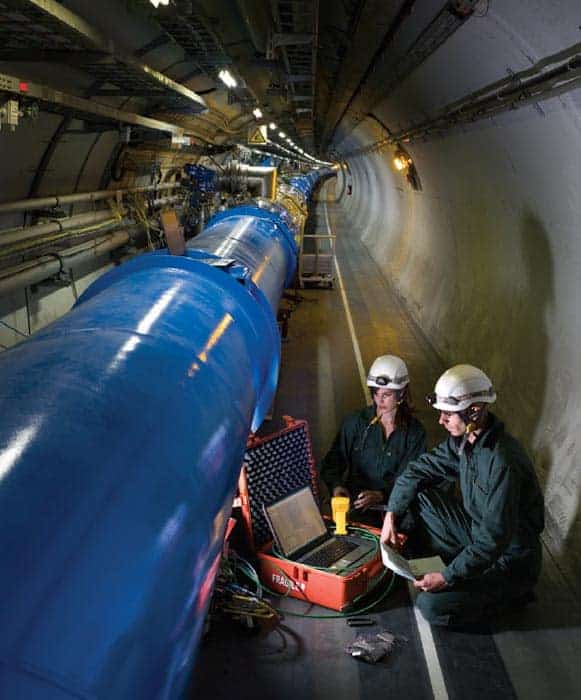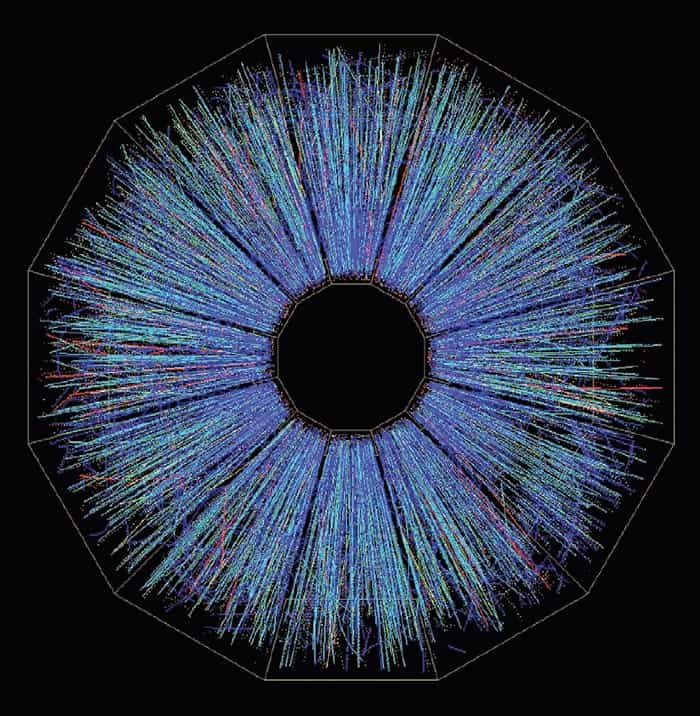Edwin Cartlidge examines the case of a US lawyer who believes that the courts must step in if required to halt experiments like the Large Hadron Collider

Before the Large Hadron Collider (LHC) was switched on at CERN in September 2008, stories abounded that the machine might destroy the planet. The fear was that the €6.3bn LHC, which will collide protons together at energies of up to 14 TeV, would be powerful enough to create mini black holes that could consume the Earth – or that it might produce hypothetical “strangelet” particles that could convert the planet into a lump of ultra-dense “strange” matter. These stories certainly left their mark, with people telephoning the Geneva lab in tears imploring researchers not to switch on the accelerator.
Those at CERN never had any doubts that the LHC was safe. Safety reviews published in 2003 and 2008 both concluded that there was no danger that the particle collisions would lead to devastation. These reviews ultimately rested on the simple observation that higher-energy versions of these collisions take place billions of times each second in nature when cosmic rays smash into every object in the universe – bombardments that leave the Earth and all else intact. Indeed, since the collider restarted last November, it has generated record-breaking proton–proton collisions of 2.36 TeV without incident.
Some people, however, remain unconvinced and have tried to halt the LHC through the courts. Plaintiffs have filed lawsuits in Switzerland, Germany, Hawaii and the European Court of Human Rights. However, to date, no action has resulted in a decision on the merits of the case. The Swiss lawsuit was dismissed because CERN straddles the Franco-Swiss border and the lab’s treaties with France and Switzerland guarantee it immunity from legal process in both countries. The Hawaii suit was thrown out because the judge handling the claim ruled that US funding and participation in the LHC did not provide the Hawaii court with sufficient jurisdiction under the environmental law invoked by the plaintiffs.
However, Eric E Johnson, a lawyer at the University of North Dakota in the US, believes that such jurisdictional problems should not prevent justice from being done. Johnson has published a 90-page paper in the Tennessee Law Review (2009 76 819) arguing that the courts must use their power to halt hypothetically cataclysmic experiments such as the LHC if they are called upon to do so, and he puts forward the criteria by which the courts could pass meaningful judgements in such cases (see also arXiv:0912.5480v2).
Johnson claims that he has no intent or desire to shut down the LHC – or to “engender fear” – but believes that there are grounds for questioning CERN’s safety case. He acknowledges that the courts risk being manipulated by “frivolous objectors” if they simply decide it is better to be safe than sorry when confronted with requests for injunctions against extremely complex experiments like the LHC. But he believes that the courts must not shirk responsibility. “If the judiciary refuses to involve itself in such disputes, then the rule of law is lost,” he writes.
Courting trouble
The LHC is not the first accelerator to spark fears about possible catastrophes. Similar concerns arose following an exchange of letters in the July 1999 issue of Scientific American between particle theorist Frank Wilczek, who was then at the Institute for Advanced Study in Princeton, and reader Walter Wagner about collisions of gold ions at the Relativistic Heavy Ion Collider (RHIC) at the Brookhaven National Laboratory in the US. Wagner feared that the collisions might produce the dreaded strange-quark containing strangelets.
Brookhaven’s then director John Marburger appointed a committee of scientists led by Robert Jaffe of the Massachusetts Institute of Technology (MIT) to examine the matter before RHIC started up in 2000. The committee, which included Wilczek, concluded that strangelets posed no threat, partly because stable strange matter has never been observed anywhere else in the universe. It also saw no risk of RHIC producing Earth-devouring microscopic black holes because the collider would not be powerful enough to generate the gravitational forces required.
Unconvinced, Wagner, who was one of the two plaintiffs in the Hawaiian case against the LHC, filed a lawsuit in California in May 1999 to have RHIC stopped. It was eventually dismissed because the Californian courts said they had no jurisdiction over what takes place in New York, where the Brookhaven lab is located. A separate suit, filed by Wagner in New York in 2000, was also thrown out, because the Californian case was being actively pursued at the time.
Although RHIC started up without incident, fears over the safety of colliders did not end there. In 2002 Steven Giddings, a string theorist at the University of California, Santa Barbara, suggested that the argument in the Jaffe report might not apply if space has more than the familiar three dimensions, just as string theory proposes (Phys. Rev. D 65 056010). The idea is that gravity appears much weaker than the other fundamental forces because it leaks into these tiny, extra dimensions. Accessing these tiny length scales, which would be within the reach of the LHC, might then provide the strength of gravity needed to produce microscopic black holes.
Seeking to head off similarly negative reaction to the LHC, the then director-general of CERN Luciano Maiani set up a committee to look into the new collider’s safety. Reporting in 2003, it acknowledged that black holes could potentially be produced by the collider, but that they would evaporate before doing any damage. However, some physicists continued to speculate that black holes might not necessarily evaporate and in 2007 CERN set up another safety panel – the LHC Safety Assessment Group (LSAG).
Its safety case was based on a refined version of the cosmic-ray argument contained in a detailed paper by Giddings and Michelangelo Mangano of CERN (Phys. Rev. D 78 035009). It had been suggested that the continued existence of the Earth might not prove the LHC was safe because the mini black holes created by cosmic rays would pass straight through the planet at high speed, whereas those made in the Geneva lab would linger inside the detectors (since the colliding protons meet each other head on). But Giddings and Mangano showed that certain kinds of white-dwarf star would be dense enough to trap mini black holes, if they existed. The fact that we observe these white dwarfs, the pair argued, proves that such black holes either do not exist or do no damage.
LSAG also concluded that the LHC, operating in heavy-ion mode, would be less likely to generate strangelets than RHIC, which – a decade after firing up – has still not produced any strangelets. “There is no basis for any conceivable threat from the LHC,” said the LSAG report, which was subsequently endorsed by CERN’s scientific-policy committee. “Indeed, experimental and theoretical developments since 2003 have reinforced this conclusion.”
Unearthing flaws
In his legal analysis, Johnson acknowledges that neither he nor any other non-physicist can hope to thoroughly evaluate the scientific substance of CERN’s safety case. But he believes there are plenty of “human factors” that would allow a court to sensibly pass judgement on this and other similar cases. Among these are the extent to which the theories underlying the safety case have become well established or are still the subject of debate between scientists. He regards the understanding of black holes to be in the latter category.
Even if such basic theory appears sound, Johnson also believes that courts could identify the potential for smaller-scale errors of modelling, calculation or observation. He points out that such errors have occurred before, such as when physicists at Los Alamos overlooked the effects of lithium-7 within the “Castle Bravo” H-bomb test of 1954, which led to the bomb’s explosive yield being underestimated by a factor of three. Johnson acknowledges that second guessing the assumptions of an incredibly detailed scientific analysis such as that carried out by Giddings and Mangano would be hard work; but he points out that Cambridge University quantum physicist Adrian Kent claims to have identified flaws in both the Jaffe report and in a separate report on the safety of heavy-ion collisions by Arnon Dar and two other colleagues at CERN.
In his paper, Johnson also discusses how psychology and sociology could be utilized in the courtroom. He points out that scientists may be predisposed not to believe that one of their experiments could wreak havoc, particularly when billions of dollars and years of work have been invested in it. Johnson also discusses the potential for “groupthink” – the idea, developed by psychologist Irving Janis, that striving for unanimity can override individual critical thinking. In addition, he believes that CERN’s safety reviews have been weakened by a significant conflict of interest: while all but one of the members of the 2003 LHC Safety Study Group were from outside CERN, there was only one outsider on the LSAG panel.
Rigorously reviewed
In response to Johnson, CERN communications chief James Gillies says that the lab’s safety analyses have undergone rigorous review. He points out that all of CERN’s operations must be endorsed by the lab’s governing council, which consists of representatives of the lab’s 20 member states. He also says that the scientific-policy committee is made up of non-CERN scientists and that the LSAG study underwent peer review.
One LSAG panel member – CERN theorist John Ellis – is highly critical of Johnson’s paper, saying it reads like “the prosecution in a Perry Mason trial, with every phrase unfriendly to the particle physicist”. Specifically, he points out that Johnson mistakenly states that the LHC is designed to “create particles that have not existed since the time of the Big Bang”, whereas the LHC will only produce particles already generated in cosmic-ray collisions. Moreover, as Fermilab particle physicist Don Lincoln points out, physicists have close control over these collisions. “The type of science we are doing is not nearly as unusual as you might think,” says Lincoln, who is also a member of the CMS collaboration at CERN.
Johnson believes that his formula for handling the black-hole case could also be applied to other potentially apocalyptic branches of science, such as nanotechnology, genetic engineering and artificial intelligence. Lincoln, however, remains cautious, arguing that the adversarial US legal system is not well suited to assessing scientific cases because it can give unjustified weight to arguments not supported by the science. He also believes that judges or jurors reviewing such cases would have to fully understand the science being reviewed. “I would hate to see the fate of any scientific project rest on a silver tongue instead of a scientific fact,” he adds.
Ellis, too, does not see how a court can avoid the question of whether the science is right, adding that “the job of the court is to get at the truth”. In any case, he believes the case against the LHC has been closed for some time. “Every time someone comes up with a new theoretical speculation about accelerator safety, it is interesting to see why that speculation does not constitute risk, but it always comes back to the cosmic-ray argument,” he says. So does that mean these safety reviews are nothing more than a curiosity? “Correct. There is no scientific motivation for these reviews. They are a foregone conclusion, even though the community has the right to expect CERN to demonstrate the validity of the safety arguments.”
Kent disagrees. He would prefer an experiment to be risk-assessed by independent experts before it is built – rather than by ad hoc panels set up in response to media interest – and to only go ahead if the risk is less than what scientists deem acceptable. But whether this approach is necessary – and indeed practicable – remains an open question.




